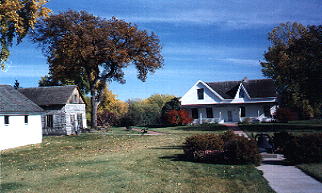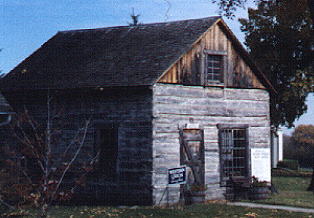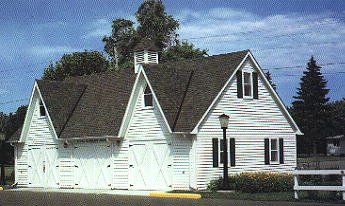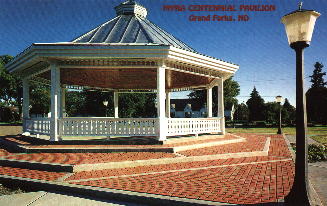

 Welcome to the grounds of the Grand Forks County Historical Society located at 2405 Belmont Road in Grand Forks, North Dakota.
Welcome to the grounds of the Grand Forks County Historical Society located at 2405 Belmont Road in Grand Forks, North Dakota.
The grounds consist of the historic Thomas Campbell house, the Myra Museum, the log cabin post office, one-room schoolhouse, and the Carriage house. The Grounds also boast a band pavilion that is used for weddings and band concerts in the summer. Spend a bit of time exploring the grounds and discover the Myra Museum, the birthplace of Thomas Campbell, Log Cabin Post Office, a one-room Schoolhouse and a Carriage House.

The historical society was founded in October 1970 and were dedicated to preserving the history of the city of Grand Forks and of the County of Grand Forks in North Dakota. The goal of the society to this day is the preservation of the heritage of the Red River Valley for future generations. Join us as we visit the Red River Valley's past as seen through eyes of Grand Forks' past from the days of the 1870's when people first started settling the area to present day. The grounds have seen the coming and going of nature and has survived many trials and tribulations including the Restoration of the historic Campbell House was the first project of the society and as time went on the other aspects of the city's and county's history were added. Restoration of the historic Campbell House was the first project of the society and as time went on the other aspects of the city's and county's history were added. The society grounds have seen many trials and tribulations through time that nature has brought upon them including the Great Red River Flood of 1997
 The Myra Musuem vividly displays our heritage through a wide array of displays and the Quiet Room which is dedicated to the Hagert-Sand families who pioneered in the Emerado area. It houses the society's photo collections, archives and artifact storage and research. The museum was built on the grounds of the society in 1976 and the architecture of the museum blends with the design of the historic Campbell house. With in the museum one can find many displays relating to the history of Grand Forks and the surrounding area including a model of Metropolitan Opera House, a chruch interior, a Red River oxcart, the Colleen Grosz glass collection among other displays. This museum is just one many educational and cultural projects established by the Myra Foundation, named for a prominent farmer and lumber man, John Myra. The museum has seen many things through its historical eyes in Grand Forks and the outlying county area including the devastating Red River flood of 1997. The historical society recieved a preservation awary 1998 for its work in preserving history after the devastating 1997 flood by the Red River Valley Historic Preservation Society in Moorhead, MN.
The Myra Musuem vividly displays our heritage through a wide array of displays and the Quiet Room which is dedicated to the Hagert-Sand families who pioneered in the Emerado area. It houses the society's photo collections, archives and artifact storage and research. The museum was built on the grounds of the society in 1976 and the architecture of the museum blends with the design of the historic Campbell house. With in the museum one can find many displays relating to the history of Grand Forks and the surrounding area including a model of Metropolitan Opera House, a chruch interior, a Red River oxcart, the Colleen Grosz glass collection among other displays. This museum is just one many educational and cultural projects established by the Myra Foundation, named for a prominent farmer and lumber man, John Myra. The museum has seen many things through its historical eyes in Grand Forks and the outlying county area including the devastating Red River flood of 1997. The historical society recieved a preservation awary 1998 for its work in preserving history after the devastating 1997 flood by the Red River Valley Historic Preservation Society in Moorhead, MN.
 Built in 1879, ten years before North Dakota statehood, was a log cabin where a boy named Tom grew up. The boy was Thomas Campbell who grew up to be known as the Wheat King, while his boyhood home became known as the Campbell house. When Thomas Campbell died, he requested that the home be dedicated in memory of his mother, Almira Richards Campbell and all pioneer women. Today the house still has furnishings of pioneer family life, including a working loom, children's room, and a summer kitchen. The Campbell House is on the National Historic Register. The house has a variety of displays of furnishings that one might have seen in a farm home in the late 1800s and early 1900s in North Dakota.
Built in 1879, ten years before North Dakota statehood, was a log cabin where a boy named Tom grew up. The boy was Thomas Campbell who grew up to be known as the Wheat King, while his boyhood home became known as the Campbell house. When Thomas Campbell died, he requested that the home be dedicated in memory of his mother, Almira Richards Campbell and all pioneer women. Today the house still has furnishings of pioneer family life, including a working loom, children's room, and a summer kitchen. The Campbell House is on the National Historic Register. The house has a variety of displays of furnishings that one might have seen in a farm home in the late 1800s and early 1900s in North Dakota.
 This log cabin was originally built in 1869 by Sanford Cady, an early pioneer in the area. The building was possibly used as post office and a small store for dual operations were not unusual. The building was discovered during urban renewal in Grand Forks in the early 1970s and moved to the grounds in 1975. The building was restored into a post office and general store. The building today has items that are representative of an early general store and post office complete with a wooden mail front and boxes. There are items that a person might find and an early rural general store such as foodstuffs, dishes, perhaps some jewels and candy for the kids. There is also and stove in the corner that might have been a gathering spot for local gossip and news of people coming in from various farms to get the news and visit with friends. The loft of the post office as a display of old telephone equipment for installing poles and lines and it also includes an old phone booth and switchboard.
This log cabin was originally built in 1869 by Sanford Cady, an early pioneer in the area. The building was possibly used as post office and a small store for dual operations were not unusual. The building was discovered during urban renewal in Grand Forks in the early 1970s and moved to the grounds in 1975. The building was restored into a post office and general store. The building today has items that are representative of an early general store and post office complete with a wooden mail front and boxes. There are items that a person might find and an early rural general store such as foodstuffs, dishes, perhaps some jewels and candy for the kids. There is also and stove in the corner that might have been a gathering spot for local gossip and news of people coming in from various farms to get the news and visit with friends. The loft of the post office as a display of old telephone equipment for installing poles and lines and it also includes an old phone booth and switchboard.
 The one-room schoolhouse was built in 1917 and is the result of local desire for preserving our heritage. The school house was originally built in Blooming Township, near present-day Larimore, ND. The building's purchase, restoration, and relocation represent a community effort commemorating the Grand Forks Public School District's 100th anniversary. The display within the school house is a cumulative collection of items used in a one-room school house between 1870s to the early 1940s including textbooks, an old stove, wooden desks and various other items that may have been in a one-rooms school.
The one-room schoolhouse was built in 1917 and is the result of local desire for preserving our heritage. The school house was originally built in Blooming Township, near present-day Larimore, ND. The building's purchase, restoration, and relocation represent a community effort commemorating the Grand Forks Public School District's 100th anniversary. The display within the school house is a cumulative collection of items used in a one-room school house between 1870s to the early 1940s including textbooks, an old stove, wooden desks and various other items that may have been in a one-rooms school.
One-room school houses once dotted the landscape with only a handful still being used in North Dakota with only a few in operation today in the far western edge of the state. The last one room school closed in Grand Forks in the 1970's in Rye Township.
 Although the carriage house is a newer building it is designed to compliment the design of the Campbell house and the Myra Museum in a style of bygone days. The project was funded by the Myra Foundation and it includes display area and shop. It was designed to blend in with the other buildings on the grounds and complement the architectural style of the Campbell House and the Myra Museum. The Carriage houses various wagons, sleighs and buggies that early settlers may have used. Various tools and hand implements are displayed on the wall to reprent a variety of farming activities.
Although the carriage house is a newer building it is designed to compliment the design of the Campbell house and the Myra Museum in a style of bygone days. The project was funded by the Myra Foundation and it includes display area and shop. It was designed to blend in with the other buildings on the grounds and complement the architectural style of the Campbell House and the Myra Museum. The Carriage houses various wagons, sleighs and buggies that early settlers may have used. Various tools and hand implements are displayed on the wall to reprent a variety of farming activities.
 The band pavilion was added to the grounds in 1989, the centennial of North Dakota statehood. It was funded in part by the Myra Foundation and was designed to resemble the band pavilions of a bygone era. The Pavilion can be reserved for picnics, weddings or other private gatherings. The pavilion has become a popular location for summer band concerts and for weddings. On certain evenings in the summer the Grand Forks City Band schedules free concerts for people to come and listen to in the summer and it is a wonderful way to spend a delightful evening with good music and friends.
The band pavilion was added to the grounds in 1989, the centennial of North Dakota statehood. It was funded in part by the Myra Foundation and was designed to resemble the band pavilions of a bygone era. The Pavilion can be reserved for picnics, weddings or other private gatherings. The pavilion has become a popular location for summer band concerts and for weddings. On certain evenings in the summer the Grand Forks City Band schedules free concerts for people to come and listen to in the summer and it is a wonderful way to spend a delightful evening with good music and friends.

The Grand Forks County Historical Society is open from 1:00 - 5:00 pm daily from May 15 to September 15. Tour arrangements of the Myra Museum during the winter can be made by calling (701) 775-2216. Admission is $1.50 for ages 10-15 and $3.00 for ages 16 and up. Children under 10 are admitted free but must be accompanied by an adult. Annual events at the historical society include an Ice Cream Social held on the second Sunday in July and the Metropolitan Dinner held in the fall.
Curious to leam more about us or have a question about Grand Forks history? Drop us a line.
 Grand Forks County Historical Socity
Grand Forks County Historical Socity